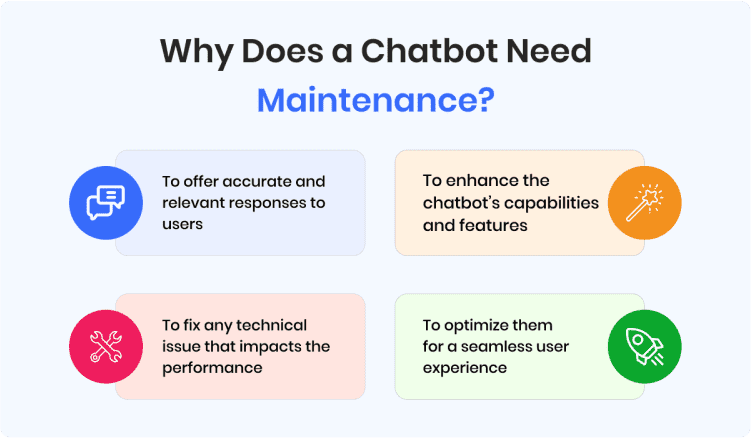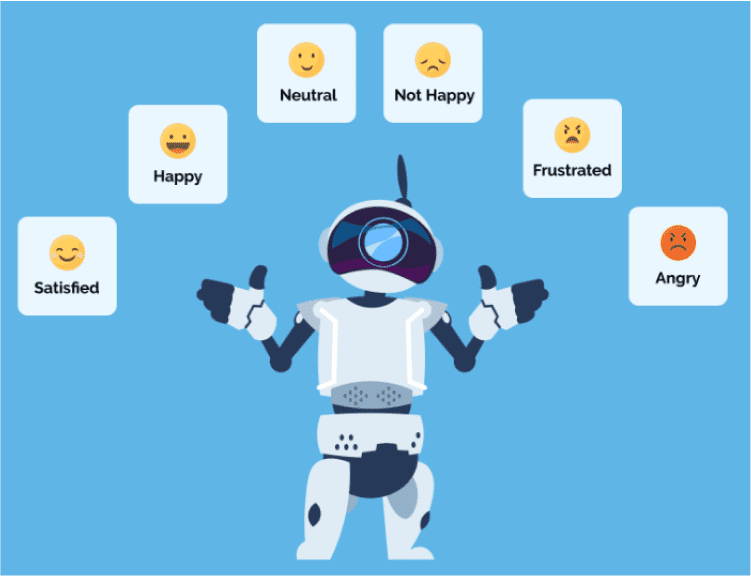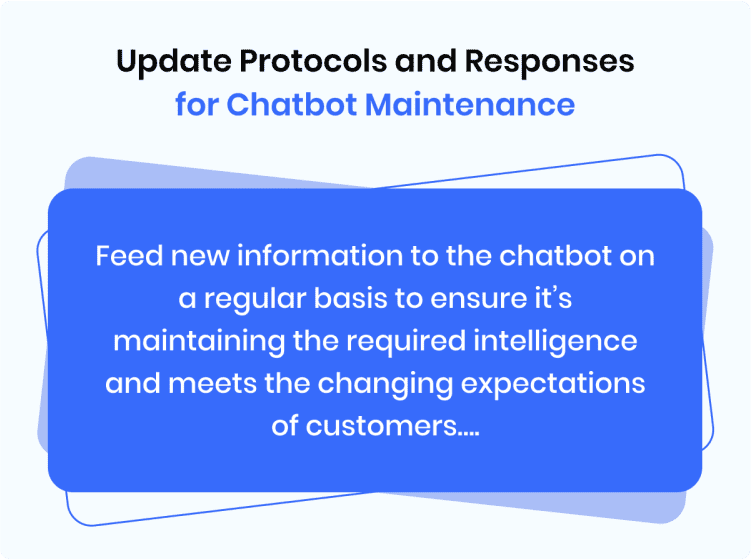In recent times, chatbots have emerged as very helpful tools for businesses to automate repetitive tasks and help users with simple requests anytime. They are smart, powerful, and can handle up to 80% of common support queries and tasks without any human help from the outside. And that’s why more companies are deploying them for various tasks across sales, support, and marketing.
However, chatbots need regular training and maintenance to keep pace with the changing user demands and content. They need improvement to perform optimally and offer the best user experience. And if a chatbot is not trained and maintained, it might soon feel outdated and may fail to deliver the kind of responses users expect.
Additionally, regular chatbot maintenance can also help in fixing any technical issue or security flaw that may stop it from offering the most logical and relevant answers to user queries.
In this post, we will look into chatbot maintenance from different aspects and also analyze the importance, benefits, and best practices of maintaining a bot.
Why Does a Chatbot Need Maintenance?
Most chatbots these days rely on AI technology which is changing and evolving at a rapid rate. Regular maintenance can keep the chatbot updated with new technology and information. And when the chatbot is up-to-date, it can handle queries of any complexity with ease and add value to users at any stage of the journey with a brand.
A chatbot may need maintenance for a variety of reasons, including –
- Improved accuracy – Chatbots are prone to giving incorrect and irrelevant responses if not maintained regularly with the latest queries and content. So, they need to be trained with the latest database and conversational strands to offer relevant responses to queries. Not training on this can greatly affect the quality of engagement and user experience a bot can deliver.
- Better engagement – No matter how advanced a chatbot is, after a while, it will cease to deliver accurate responses due to a lack of maintenance. And this can hugely affect its ability to engage with users.
- Efficiency and promptness – An updated chatbot will obviously show more efficiency toward user queries. Most of the time, such tools also deliver quick answers and therefore ensure improved satisfaction levels among customers.
- A seamless user experience – A chatbot can provide a seamless experience to users only when it’s optimized and kept free of minor issues. The more you take care of the maintenance, the more enjoyable experience you can deliver to users.
- Cost savings – Chatbot maintenance can not only improve its performance but can also make your support agents more productive as well. A trained bot can also offer accurate responses 24×7 or they can also answer questions when agents are not available. All this can help businesses optimize support costs.
Chatbot Maintenance Best Practices and Tips
Chatbot maintenance is often an ongoing process. Your bot may need maintenance long after it has been developed and deployed. And you can enhance the user experience with your brand only when the chatbot is maintained on a regular basis.
Some of the useful tips and chatbot maintenance best practices include –
1. Sentiment Analysis Training
Chatbot sentiment analysis is a key feature for businesses to understand what people are saying about them, how they are saying it, and what they actually mean with the things they say. Since chatbots can be trained on sentiment, it becomes very easy for organizations to deploy a bot across channels and analyze customer sentiment, resulting in a better understanding of users and their motives.
For best results with the chatbot sentiment analysis feature, the maintenance part needs to look into these –
-
Continuously use the advances in natural language processing to train the bot with sentiment analysis
-
Analyze and use statistical models and text analysis
-
Label more conversations and utterances and clearly define the categories of sentiments
-
Understand that pre-trailed models may be good but they can’t always work perfectly for your organization’s specific user case
2. Training Fallback Queries
No matter how advanced a chatbot is, there will come a user question that can leave it confused, or that can make it unable to answer it. Despite having all the elements in the right place, from a great conversation design to human handovers to seamless integrations, your chatbot might falter with some questions sometime and your organization needs to be ready for this situation. That’s why training the bot with the best fallback response is key.
While training feedback queries, you need to keep in mind a few things –
- Keep analyzing user responses with the view to better train your conversational chatbot and ensure a flawless conversational flow
- Train the chatbot in a way that it can collect the query from the user for review and evaluation
- Train your chatbot so that it can offer a variety of responses and avoid users the bad experience
- Try to customize the chatbot’s fallback response as per the context of the conversation
- Offer the user the option and flexibility to escalate their query for scenarios where offering fall options can’t help much
3. Add More FAQs
A chatbot should answer customer queries without any trouble and as quickly as possible. Similarly, the bot should be designed in a way to comprehend user motives easily as it can also enhance its operational efficiency manifold. Else, what purpose of having a website chatbot when it can serve a business purpose well?
However, many chatbots are developed and launched with a limited set of FAQs that adversely impact their capability and also limit their scope of providing answers. And if you want your chatbot not to be limited by that, consider adding more FAQs and intents to it.
While adding FAQs and intents, keep in mind these things –
- Add only those FAQs that are already not present in the knowledge base
- Make sure the intents are added in the proportion to the common questions present in the knowledge base
- Consider using a chatbot design platform that places no limit on the FAQ or
4. Intent Training
An intent-based chatbot can work by detecting the user intent. Such chatbots don’t rely on a specific input and are rather trained to identify the meaning a message is conveying and then they offer a relevant response.
When a chatbot is not trained on identifying user intents, chances are it might fail to offer the kind of relevant responses it should. Intent training is therefore key to keeping your chatbot adept at recognizing the intent behind a message.
Two key things to remember with intent training are –
- Create specific intents for specific purposes to avoid the chatbot from creating a bad experience for users
- Train the bot to cover if not all then most potential phrasings and do this by continually updating the custom values and utterances
5. Update Protocols and Responses
A chatbot is never a finished product. From time to time, it will need your attention. You must monitor it and update it regularly if you want to keep providing accurate responses. And if you don’t test it, chances are you might miss its progress and performance in accordance with the changing landscape of technology around.
Make sure you do these –
- Feed new information to the chatbot on a regular basis to ensure it’s maintaining the required intelligence and meeting the changing expectations of customers always
- Update the FAQ database so that the chatbot can maintain the ability to deliver accurate responses against most queries
- Code more responses and interactions into your chatbot so that it can successfully handle diverse standards of conversations and reactions from users
- Train and update the bot to the point that is can automatically get data from past interactions with customers.
By updating these protocols and responses, you can make good progress in terms of chatbot maintenance and hopefully witness a better engagement rate with customers.
6. Track User Conversations
When your business uses a chatbot, it’s very important to keep analyzing and evaluating its performance from time to time. Doing this is key to understanding the areas where improvements are needed and where changes are essential.
To measure a chatbot’s performance, the key is to review its interactions with customers and seek feedback. Once the feedback is available, you can get a good idea of what makes the bot tick and what does not.
By tracking user conversations, you can know many things, including –
- The reasons why customers are not able to engage with your chatbot beyond a point
- The instances or the type of conversational strands where the chatbot fails to live up to customer expectations
- The kinds of queries your chatbot is finding hard to successfully answer
- The types of words or phrases or sentences your chatbot are finding hard to interpret
- The various hues of customer emotions and sentiments that the chatbot is not able to decipher
By tracking user conversations, you can maintain your chatbot to the point where it never fails to understand customer queries of any complexity.
7. Validate the Success of Your Chatbot
The true success of a chatbot lies in its ability to respond to customer queries in a prompt and efficient manner. And if yours does that, chances are it may be contributing massively to supporting your customers and getting a good return on investment (ROI).
However, not all chatbots are created equal; therefore, not all can be equally successful. The trick, therefore, is to validate the success of your bot and check if it achieves the intended goals or not. And for that, you need some valuable data and analytics.
To validate the success of your chatbot, you need to do a few things, including –
- Collect key customer or user data and extrapolate them against your goals
- Extract and analyze past data from customer interactions
- Gain valuable insights on your customer satisfaction in regard to their experience or conversations with the bot
Once you’re ready to leverage data and analytics, it becomes quite easy to validate the operational efficiency of a chatbot. And this is often a key aspect of bot maintenance.
8. Update Existing Content
Users often expect a chatbot to stay up-to-date with things concerning them. They also expect the bot to provide the most relevant and logical answer or explanation for their queries. For a chatbot design to meet such expectations, among other things, it must always be using updated content. Else, the responses may not be appropriate.
That’s why chatbot maintenance sometimes may also mean –
- Constantly updating the existing content
- Removing outdated content
- Fine-tuning the content in accordance with the new features, policies, and procedures
- Regularly reviewing and revising training examples to optimize intent recognition based on the user’s journey and queries
- Syncing the content across resources and knowledge management systems so that the chatbot can easily map intents from one system to another
While updating existing content is a time-consuming and strenuous process, it’s something you need to do on an ongoing basis to ensure dynamic maintenance for your bot.
9. Consider Adding More Features
Keep improving your chatbot will perhaps be the best maintenance thing you could ever do. After all, the technology behind bots is changing at a rapid rate, and not maintaining pace can leave the chatbot redundant. Not maintaining pace also means you can’t join that 64% of businesses that use chatbots to deliver personalized experiences to their customers.
Since new features and tools surface on a regular basis, make sure you add them to your chatbot design and improve the overall performance of your bot. It’s important to keep an eye on the latest software and frameworks that are available and used by others.
Regardless of the chatbot maintenance effort, you should consider enriching your tool with any technology or innovation that is worth investing in. Else, the bot you have may serve only a functional purpose and might fail to add value to users.
Build a Powerful Chatbot with the REVE Platform and Save Maintenance Costs
Building a powerful chatbot is as important as ensuring its maintenance. And if you don’t maintain your chatbot, you might not be able to utilize its full potential ever.
At REVE Chat, we understand how developing as well as maintaining a chatbot should be a hassle-free exercise and that’s why we ensure help for both.
Using our platform, you can build a feature-rich, advanced, and AI-powered chatbot for your business and ensure value across marketing, sales, and support.
Apart from the bot, you can also find a range of other customer engagement tools for your business such as co-browsing software, video chat software, etc.
You can also combine live chat software with the bot and enhance the value and efficiency of customer support.
Leverage the REVE Platform to Keep Your Chatbot Future-Ready with Regular Maintenance
Regular maintenance is the only thing that can keep your chatbot ready for future challenges and be able to deliver value as and when needed.
With REVE Chat, you can start free trial of an AI chatbot and see where it fits into your business needs.
There are other equally helpful tools you can check and evaluate for meeting varied business goals.







